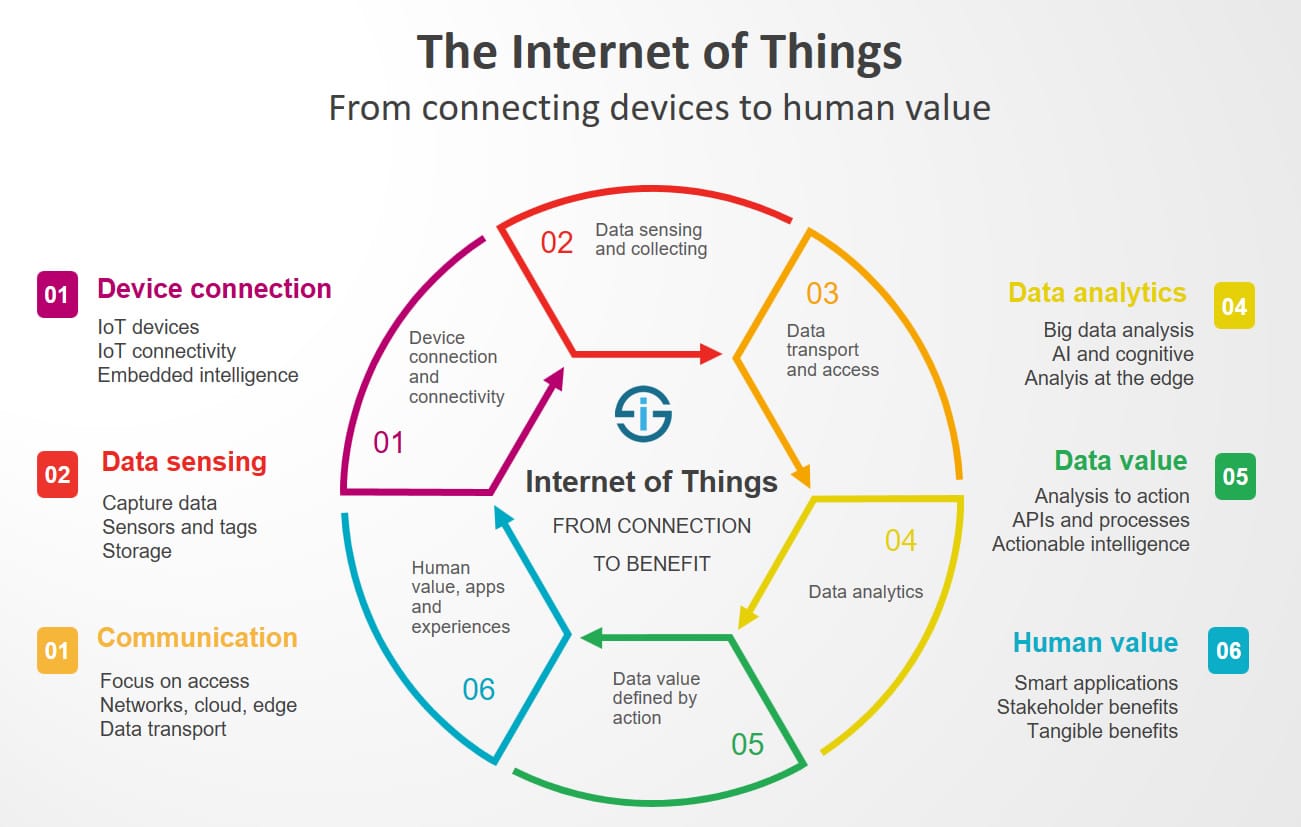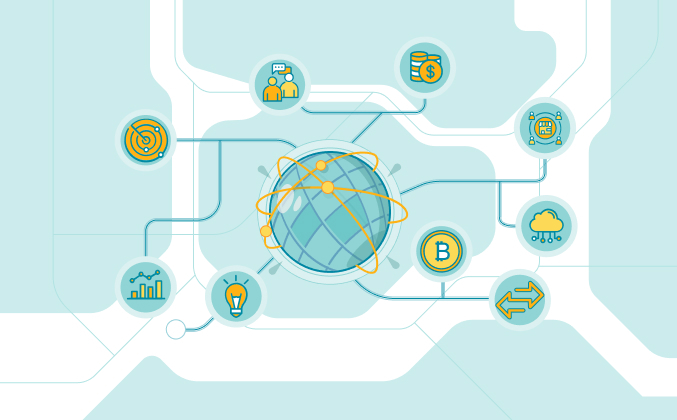
The Internet of Things, or IoT, refers to the billions of physical devices around the world that are now connected to the internet, all collecting and sharing data. Thanks to the arrival of super-cheap computer chips and the ubiquity of wireless networks, it's possible to turn anything, from something as small as a pill to something as big as an aeroplane, into a part of the IoT. Connecting up all these different objects and adding sensors to them adds a level of digital intelligence to devices that would be otherwise dumb, enabling them to communicate real-time data without involving a human being. The Internet of Things is making the fabric of the world around us more smarter and more responsive, merging the digital and physical universes.
What is an example of an Internet of Things device?
Pretty much any physical object can be transformed into an IoT device if it can be connected to the internet to be controlled or communicate information.
A lightbulb that can be switched on using a smartphone app is an IoT device, as is a motion sensor or a smart thermostat in your office or a connected streetlight. An IoT device could be as fluffy as a child's toy or as serious as a driverless truck. Some larger objects may themselves be filled with many smaller IoT components, such as a jet engine that's now filled with thousands of sensors collecting and transmitting data back to make sure it is operating efficiently. At an even bigger scale, smart cities projects are filling entire regions with sensors to help us understand and control the environment.
What it means for IoT:
The term IoT is mainly used for devices that wouldn't usually be generally expected to have an internet connection, and that can communicate with the network independently of human action. For this reason, a PC isn't generally considered an IoT device and neither is a smartphone -- even though the latter is crammed with sensors. A smartwatch or a fitness band or other wearable device might be counted as an IoT device, however.
What is the history of the Internet of Things?
The idea of adding sensors and intelligence to basic objects was discussed throughout the 1980s and 1990s (and there are arguably some much earlier ancestors), but apart from some early projects -- including an internet-connected vending machine -- progress was slow simply because the technology wasn't ready. Chips were too big and bulky and there was no way for objects to communicate effectively.
Processors that were cheap and power-frugal enough to be all but disposable were needed before it finally became cost-effective to connect up billions of devices. The adoption of RFID tags -- low-power chips that can communicate wirelessly -- solved some of this issue, along with the increasing availability of broadband internet and cellular and wireless networking. The adoption of IPv6 -- which, among other things, should provide enough IP addresses for every device the world (or indeed this galaxy) is ever likely to need -- was also a necessary step for the IoT to scale.
The IoT was initially most interesting to business and manufacturing, where its application is sometimes known as machine-to-machine (M2M), but the emphasis is now on filling our homes and offices with smart devices, transforming it into something that's relevant to almost everyone. Early suggestcluded 'blogjects' (objects that blog and record data about themselves to the internet), ubiquitous computing (or 'ubicomp'), invisible computing, and pervasive computing. However, it was Internet of Things and IoT that stuck.
How big is the Internet of Things?
Big and getting bigger -- there are already more connected things than people in the world.
Tech analyst company IDC predicts that in total there will be 41.6 billion connected IoT devices by 2025, or "things." It also suggests industrial and automotive equipment represent the largest opportunity of connected "things,", but it also sees strong adoption of smart home and wearable devices in the near term.
Another tech analyst, Gartner, predicts that the enterprise and automotive sectors will account for 5.8 billion devices this year, up almost a quarter on 2019. Utilities will be the highest user of IoT, thanks to the continuing rollout of smart meters. Security devices, in the form of intruder detection and web cameras will be the second biggest use of IoT devices. Building automation – like connected lighting – will be the fastest growing sector, followed by automotive (connected cars) and healthcare (monitoring of chronic conditions).
What are the benefits of the Internet of Things for business?
The benefits of the IoT for business depend on the particular implementation; agility and efficiency are usually top considerations. The idea is that enterprises should have access to more data about their own products and their own internal systems, and a greater ability to make changes as a result.

What is the Industrial Internet of Things?
The Industrial Internet of Things (IIoT) or the fourth industrial revolution or Industry 4.0 are all names given to the use of IoT technology in a business setting. The concept is the same as for the consumer IoT devices in the home, but in this case the aim is to use a combination of sensors, wireless networks, big data, AI and analytics to measure and optimise industrial processes.
If introduced across an entire supply chain, rather than just individual companies, the impact could be even greater with just-in-time delivery of materials and the management of production from start to finish. Increasing workforce productivity or cost savings are two potential aims, but the IIoT can also create new revenue streams for businesses; rather than just selling a standalone product – for example, like an engine – manufacturers can also sell predictive maintenance of the engine.
The IoT for Business Optimization
The concept behind the Internet of Things is to enhance human interaction with technology with the aim of simpler and more convenient access. IoT for business is helping organizations bring transformational and actionable solutions to different levels, such as manufacturing, supply chain, finance, customer service, network security, and backup solutions.
Boost Productivity:
Productivity is the key to business success and highly depends on employee performance. IoT provides real-time training to the workforce of an organization and helps them communicate effectively during operations. With Ioation with different connected devices that monitor, manage, and control various operations in shorter durations.
Grab New Opportunities:
The Internet of Things is opening doors for business opportunities by improving business flow, productivity, and customer experiences. This creates a growing atmosphere with the potential to transform by improving their products and services, as well as establishing better customer relationships.
Better Asset Utilization:
The IoT gives you full control over equipment, tools, and machinery using sensors. With this application, you can track your assets and get real-time performance insights as well as issue detection for immediate action.
Suppose that there is a network security issue at the office, and you’re not around to fix it. With IoT, you can shut down or reset your servers remotely before any critical damage occurs. As technology advances, it will notify you in advance so you can mitigate the risk.
Enhanced Safety and Network Security:
Network security is a major concern when it comes to IoT for business. But this isn’t anything new since anything with an internet connection is vulnerable to hack. However, IoT provides an additional layer of security to protect business data and privacy. They enhance your alertness to make your systems more secure. For example, they can notify you of a cyber attack and take prevention measures automatically.
Data Collection:
IoT for business has given organizations the capability to collect important data that can improve their products or services. For example, restaurants can use smart sensors to monitor the temperature of refrigerated items. Also, delivery services can use GPS tracking devices to create a “heat map” to see which areas have the most number of deliveries. With these resources, businesses increase their manpower or their marketing campaigns in those areas.
Data collection is probably the biggest advantage of the Internet of Things after automation and can provide important insights like consumer behavior. For example, restaurants can learn which menu items customers are ordering more using the heat map the delivery service provided.
Real-Time Analytics:
Real-time analytics can help businesses detect problems and respond accordingly. Business-ready IoT applications provide real-time insight that improves efficiency by saving the time taken to analyze problems and take corrective action.
Historical Analytics for Future Predictions:
With IoT for business, you have access to all your company’s previous data to help you predict the future. Using historical industrial data, organizations can create a predictive model that not only increases operations but also plans for contingencies in case the prediction fails.
For instance, digital marketing teams can use historical analysis of their keywords used in search engine optimization and change them according to the COVID-19 situation. For instance, using IoT applications, restaurants can automatically promote their delivery and take away models through machine learning. This way, keywords such as “Best food in my area” will change to “Best food delivery in my area.”
Cost Optimization:
Managing expenses without compromising on performance is every organization&nt, productive employees, and customer satisfaction. Thanks to IoT for business and its influence in boosting productivity and asset utilization, you can achieve success at a minimal cost.
Smooth Operations:
With devices talking to each other via the internet to drive operations, managers and analysts have more time on their hands to focus on their core business — improving their products and services. The Internet of Things gives you complete data of your supply chain, manufacturing, customer engagement, and employee performance so you can efficiently manage things.
Improved Customer Service:
You can have great products or services, but this doesn’t guarantee customer satisfaction. With IoT for business, you can help your customers interact with technology such as shipment tracking, phone-based transaction, and maintenance detection. The Internet of Things can also improve customer relationships by improving their overall experience.
With real-time data analytics, you can create frequently asked questions to reduce the time visitors spend during the purchase process.
Get Started with IoT for Business
Different businesses and environments will have different IoT use cases and models. As a result, the implementation of the IoT needs to be specific to that business or industry.